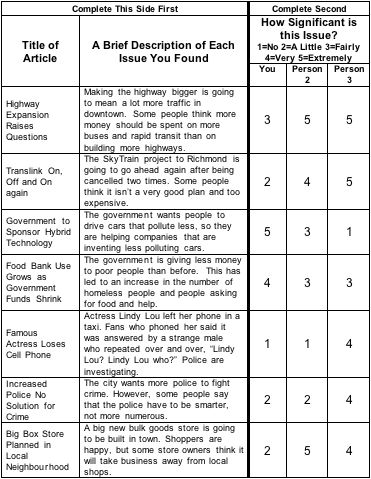3.1 Identifying Issues in Your Community
Completion requirements
Receive a grade
Part A - Identifying Issues in Your Community
- Find some issues that your community is currently facing. The issues all do not need to be major ones, such as the homeless population. You can choose ones that are smaller but important to you, such as the need for a larger soccer centre or a skateboard park. The most important detail is that these are real issues for your community. Do not make up issues (this is not a wish list) as your teacher will research them.
You are welcome to use a variety of sources, such as the news, the radio, the internet, newspapers, or by talking to various people. It is important to record where you got the information from. - After you have collected at least six issues, use the Microsoft Word template below to create a chart that lists the information about your articles. The example chart below shows how to do this part of the activity.
- Beside each issue recorded in your chart, give each item a score for how significant (important) an issue you think it is. In the column labelled“you”, score a grade of 1 to 5 to rank how significant each issue is to you. Here is the Ranking Score:
- 1=“No” not significant
- 2=“A Little” significant
- 3=“Fairly” significant
- 4= “Very” significant
- 5= “Extremely”significant
- Now, read your list to at least two other people (each one at a different time) and ask them to rank the importance of each issue. Record their results in the last two columns of the chart.
Example of Community Issues and Ratings
Part B: Reflection
To finish this activity, summarize your interview observations by answering the following questions as either separate questions or paragraph form. Please include your answers at the end of the chart template that you used above for Part A of this activity.
- Describe the people you interviewed. (age, gender, your relationship to them - friend, uncle)
- Did all three people agree on all the issues?
- Choose one issue on which at least two people agreed and explain why you think this is so.
- Did you find more significant or not significant issues in your survey?
- Describe at least one of the most significant issues you found.
- Describe something interesting in the differences of opinion you found.
